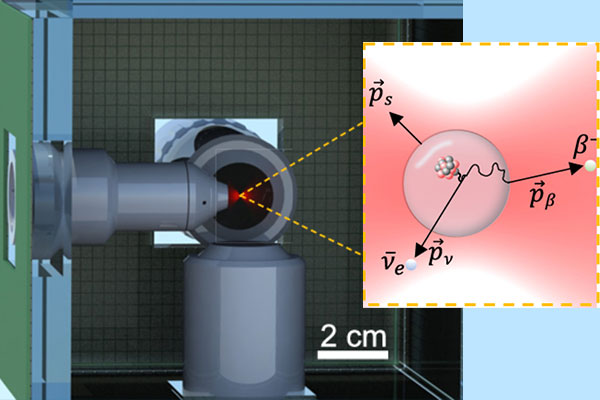In a new publication in PRX Quantum, Berkeley Lab quantum physicist Daniel Carney and colleagues propose a new method to search for invisible particles – so-called sterile neutrinos – by using a radioactive glass nanoparticle suspended in laser light.
In addition to the three neutrino species—whose tiny masses must be less than about a millionth of the electron’s—numerous theories postulate the existence of additional heavier “sterile” (non-interacting) neutrino species. Searching for these heavy neutrinos and measuring the mass of the known light neutrinos is a subject of intense research activity.
The team’s proposal includes levitating a 100-nm-diameter silica sphere in an optical trap and cooling it to its motional ground state. If the enclosed nanoparticle is filled with nuclei that decay by emitting neutrinos – such as certain argon or phosphorus isotopes – then electrons and neutrinos emitted from decaying nuclei should give the sensor a measurable increase in momentum, allowing researchers to determine the neutrinos’ momenta.
The team predicts that monitoring a single nanoparticle for one month would be equivalent to a sterile-neutrino sensitivity 10x better than that of any experiment tried so far, and they are currently working on a proof-of-principle experiment that uses alpha-emitting byproducts of radon, which would result in a larger momentum increase. Once they have optimized the techniques, the team expects that switching to beta-decaying isotopes will let them observe heavy sterile neutrinos in the 1 keV – 1 MeV mass range. They also predict that introducing more advanced quantum measuring techniques that manipulate the nanoparticle’s quantum state will enable future experiments that are sensitive to even lighter sterile neutrinos, and potentially could be extended to direct determination of the light neutrinos known to be present in the standard model.
Learn More
Searches for Massive Neutrinos with Mechanical Quantum Sensors
February 8, 2023 | Daniel Carney, Kyle G. Leach, and David C. Moore | PRX Quantum
Searching for Ghost Particles with a Mechanical Sensor
February 8, 2023 | Physics Magazine (APS)
